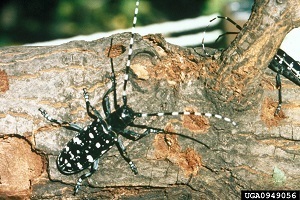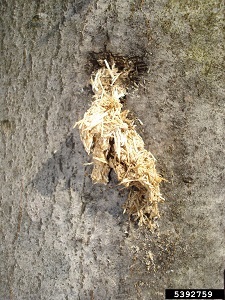|
Aug. 5, 2021
Contact: Rob Miller, 517-614-0454 or Joanne Foreman, 517-284-5814
August is Tree Check Month, and the U.S. Department of Agriculture is asking the public to look for and report any signs of the Asian longhorned beetle, an invasive pest that is not native to Michigan and could cause harm to the state’s environment and economy.

The Michigan departments of Agriculture and Rural Development; Environment, Great Lakes, and Energy; and Natural Resources are joining the USDA in asking people to take just 10 minutes this month to check trees around homes for the beetle or any signs of the damage it causes.
In late summer and early fall, adult Asian longhorned beetles drill perfectly round, 3/8-inch holes to emerge from within tree trunks and limbs, where they spend their larval stage chewing through the heartwood. After a brief mating period, female beetles chew oval depressions in trunks or branches to deposit eggs. Sometimes a material resembling wood shavings can be seen at or below exit holes or coming from cracks in an infested tree’s bark.
|
Asian longhorned beetle in the U.S.
The Asian longhorned beetle was first detected in the U.S. in 1996, when a Brooklyn, New York resident noticed a large, black beetle with irregular white spots and black-and-white banded antennae and reported it. Since that time, the invasive beetle has been found in 20 locations in six states, including New York, New Jersey, Massachusetts, Illinois, Ohio and, most recently, South Carolina.

Asian longhorned beetles likely arrived hidden in untreated wood packaging material like pallets and crates before the development of international standards for treating these materials to prevent the spread of insects.
Because adult beetles fly only short distances, it is likely that human movement of infested logs, firewood or other wood products has contributed to the spread of Asian longhorned beetle within the U.S.
To date, the USDA’s Animal and Plant Health Inspection Service has been successful in eradicating the beetle from all but four locations in the U.S. However, eradication has both financial and environmental costs. According to the USDA, over $750 million has been spent on the Asian longhorned beetle eradication program in the last 23 years, and at least 180,000 trees have been removed from infested areas.
|
You can help
The beetle has not been detected in Michigan, but discovering early signs of infestation can prevent widespread damage to the state’s forest resources, urban landscapes and maple syrup production.
“We’re asking for the public’s help to find Asian longhorned beetle and any tree damage it causes, because the sooner we know where the insect is, the sooner we can stop its spread,” said Josie Ryan, APHIS’ national operations manager for the ALB Eradication Program. “Just last year, a homeowner in South Carolina reported finding a beetle in their backyard, which led us to discover an active infestation in the state where we didn’t know the beetle was.”
Look for signs
Whenever you are outdoors this month, take time to look at the trees around you for signs of the Asian longhorned beetle, including:
- Round exit holes about the diameter of a pencil found in tree trunks and branches.
- Shallow oval or round scars in the bark, where the adult beetle chewed an egg site.
- Material that looks like wood shavings lying on the ground around the tree or in the branches.
- Dead branches or limbs falling from an otherwise healthy-looking tree.
Look for the beetle

Adult Asian longhorned beetles are distinctively large, ranging from 3/4 to 1 1/2 inches in length, not including their long antennae. The beetles are shiny black, with random white blotches or spots, and their antennae have alternating black and white segments. They have six legs that can be black or partly blue, with blue coloration sometimes extending to their feet.
|
Be aware of look-alikes
Several beetles and bugs native to Michigan often are mistaken for the Asian longhorned beetle.
- The white-spotted pine sawyer has a distinctive white spot below the base of its head – between its wings – and is brownish in color.
- The cottonwood borer is about the same size as the Asian longhorned beetle and is also black and white, but has a pattern of single, broad black stripes down each wing, and its antennae are all dark.
- The northeastern pine sawyer reaches up to 2 inches in length, has very long antennae and is gray in color.
- The eastern eyed click beetle has distinctive eye circles on the back of its head. It rolls over when threatened, then clicks and makes a flipping movement to get back on its feet.
Anyone observing an Asian longhorned beetle, or a tree that appears to have been damaged by it, is asked to report it. If possible, capture the beetle in a jar, take photos, record the location and report it as soon as possible at AsianLonghornedBeetle.com or contact MDARD at 800-292-3939 or MDA-info@Michigan.gov.
More information can be found at Michigan.gov/ALB.
Michigan's Invasive Species Program is cooperatively implemented by the Department of Environment, Great Lakes, and Energy, the Department of Natural Resources, and the Department of Agriculture and Rural Development.
/Note to editors: The accompanying photos are available for download. Caption information follows.
Adults: Adult Asian longhorned beetles emerge from within trees in late summer to mate. Females chew small depressions in tree trunks or branches, such as those seen here, to deposit eggs. Photo courtesy of Kenneth R. Law, USDA APHIS PPQ, Bugwood.org.
Identification: The Asian longhorned beetle is a large, shiny black beetle with irregular white spots and black and white banded antennae. Photo courtesy of USDA APHIS PPQ.
Frass: Material resembling wood shavings at the base of a tree or tree branches is a sign of Asian longhorned beetle infestation. Photo courtesy of Kenneth R. Law, USDA APHIS PPQ, Bugwood.org.
Pencil hole: To emerge from within a tree, adult beetles drill perfectly round, 3/8-inch exit holes. Note that holes made for tapping maple syrup may look similar to Asian longhorned beetle exit holes. Photo courtesy of Joe Boggs, The University of Ohio, Bugwood.org.
WSPS: The white-spotted pine sawyer is native to Michigan and often mistaken for the Asian longhorned beetle. Look for a white spot between the upper wings to identify this pine sawyer. Photo courtesy of William M. Ciesla, Forest Health Management International, Bugwood.org.
Cottonwood: The cottonwood borer’s antennae are all black. Photo courtesy of Gerald J. Lenhard, Louisana State University, Bugwood.org.
NEPS: The northeastern pine sawyer is a large beetle reaching 2 inches in length. Its body is primarily gray with white and black spots. Photo courtesy of Jim Brighton.
Eyed beetle: The eastern eyed click beetle is distinguished by large circles on the back of its head. Photo courtesy of iNaturalist./
|